Greenwood D.T. Advanced Dynamics
Подождите немного. Документ загружается.


389 Energy and momentum methods
where the Q
j
generalized forces are moments about the Z,
˙
θ, and k axes, respectively.
Thus, from (6.467) and (6.468), the energy rate is
˙
E =
˙
T
2
−
˙
T
0
+
˙
V
= mlrω
2
0
[
˙
φ sin θ cos(φ − ω
0
t) +
˙
θ cos θ sin(φ − ω
0
t)] (6.469)
The kinetic energy, assuming a fixed point P is
T = T
2
=
1
2
I
t
(
˙
θ
2
+
˙
φ
2
sin
2
θ) +
1
2
I
a
2
(6.470)
where the I s are taken about P and the total spin is constant.
Finally, integrating over an arbitrary time interval, we obtain
E = (T
2
+ V )
= mlrω
2
0
t
2
t
1
[
˙
φ sin θ cos(φ − ω
0
t) +
˙
θ cos θ sin(φ − ω
0
t)]dt (6.471)
The same result is obtained for
˙
E if we follow the straightforward procedure of consider-
ing the actual motion of P in finding the velocity of the center of mass and the total kinetic
energy. The calculations are more complicated, however. The Q
terms equal zero, and we
obtain
˙
E =−p
1
· ˙γ
1t
(6.472)
where p
1
and ˙γ
1t
are nonzero. The result given in (6.471) can be used to check the accuracy
of the numerical solution of the differential equations of motion (which have not been used
in obtaining the expression for
˙
E). The integration of
˙
E is accomplished concurrently with
the integration of the equations of motion, and E is considered as an extra variable. This
check will detect most programming errors.
Conservation of momentum
One can use momentum-like integrals of the motion to improve the accuracy of numerical
solutions of the equations of motion for dynamical systems. A common approach, when
it applies, is to use the Routhian method, as discussed in Chapter 2. This method applies
to systems described by the standard holonomic form of Lagrange’s equation, and which
have one or more ignorable coordinates, that is, coordinates which do not appear in the
Lagrangian function although the corresponding
˙
qs do appear. For example, if there are k
ignorable coordinates, then there are k integrals of the motion having the form
∂ L
∂
˙
q
i
= β
i
(i = 1,...,k) (6.473)
where the βs are constants and ∂ L/∂
˙
q
i
is a generalized momentum. The Routhian method
proceeds by defining the Routhian function
R(q,
˙
q, t) = L −
k
i=1
β
i
˙
q
i
(6.474)

390 Introduction to numerical methods
where the k ignorable
˙
qs have been eliminated by solving for them from the k equations of
(6.473) and then substituting into (6.474). The (n − k) differential equations of motion are
obtained from
d
dt
∂ R
∂
˙
q
i
−
∂ R
∂q
i
= 0(i = k + 1,...,n) (6.475)
More generally, the differential equations of motion for the nonignored coordinates can
include general applied forces. In this case, we obtain
d
dt
∂ R
∂
˙
q
i
−
∂ R
∂q
i
= Q
i
(i = k + 1,...,n) (6.476)
We see from (6.475) that the effective number of degrees of freedom is reduced to (n − k),
thereby simplifying the analysis, particularly if one is not interested in solving for the time
history of the ignored coordinates. It should be noted from (6.474) that one cannot simply
use (6.473) to eliminate the ignorable
˙
qs from the Lagrangian function and then continue
to use the standard form of Lagrange’s equations. This results in incorrect equations of
motion. The reason is that the standard Lagrange’s equations require that L(q,
˙
q, t) contain
a full set of n independent
˙
qs if the holonomic system has n kinematic degrees of freedom.
So-called momentum or energy constraints do not reduce the number of kinematic degrees
of freedom.
In addition to the Routhian method, there are other approaches which use conservation
of momentum to reduce the number of degrees of freedom in the dynamical analysis.
For example, isolated systems such as dynamical systems in space will have conservation
of both linear and angular momentum. Since each is a vector quantity in 3-space, if one
considers the Cartesian components of each vector, there are immediately available six
integrals of the motion. The conservation of linear momentum implies that the center of
mass of the system translates with constant velocity. Therefore, one can find an inertial
frame in which the center of mass is fixed. By using this reference frame and choosing the
generalized coordinates accordingly, one can reduce the number of degrees of freedom in
the dynamical analysis by three. A similar reduction in the rotational degrees of freedom
is not necessarily available because any rotating frame is noninertial. Nevertheless, special
situations such as planar rotational motion can be used to simplify the analysis.
Angular momentum corrections
The Routhian method of reducing the effective degrees of freedom does not apply if the
kinetic energy is expressed in terms of quasi-velocities. But quasi-velocities are commonly
used in the rotational analysis of rigid bodies; that is, the angular velocity of a rigid body is
expressed in terms of its body-axis components, and these components are quasi-velocities.
If one considers the free rotational motion of a rigid body, there is conservation of angular
momentum, and this can be used to correct errors and improve the accuracy of numerical
solutions for its motion.
The simplest approach is to correct for amplitude errors only rather than correcting the
three angular momentum components separately. The form of the square of the angular

391 Energy and momentum methods
momentum magnitude is quadratic in the us. In that respect, it resembles a kinetic energy
function, and it can be treated similarly.
As an example, consider a rigid body that is rotating in free space. Let us choose the
square of the angular momentum magnitude as an integral of the motion, that is,
P(ω) = I
2
xx
ω
2
x
+ I
2
yy
ω
2
y
+ I
2
zz
ω
2
z
= H
2
0
(6.477)
We assume principal axes at the center of mass, and H
0
is the constant magnitude of the
angular momentum.
The function P(ω) represents an ellipsoid in three-dimensional velocity space (ω-space)
and is called the momentum ellipsoid. As the rotational motion proceeds the vector ω,
drawn from the origin of the body-fixed frame, moves such that its point always lies on
the momentum ellipsoid. Due to numerical errors, however, the computed value of ω may
lie on an ellipsoid with a slightly different value of H
2
, corresponding to an error in the
angular momentum integral
P = H
2
− H
2
0
(6.478)
The correction ω is made in a direction normal to the momentum ellipsoid at the
operating point, that is, in the direction of the gradient. This minimizes the magnitude of the
correction ω resulting in the required correction H in angular momentum magnitude.
Thus, we take
ω = K ∇P (6.479)
where the gradient of P in ω-space is
∇P =
∂ P
∂ω
x
i +
∂ P
∂ω
y
j +
∂ P
∂ω
z
k
= 2I
2
xx
ω
x
i + 2I
2
yy
ω
y
j + 2I
2
zz
ω
z
k (6.480)
The constant K is chosen to provide an exact cancellation of the error if the linearization is
valid. Thus, we obtain
∇P · ω = K (∇P)
2
=−P (6.481)
which results in
K =
−P
4
I
4
xx
ω
2
x
+ I
4
yy
ω
2
y
+ I
4
zz
ω
2
z
(6.482)
Then, using (6.479), the individual corrections are
ω
x
= 2KI
2
xx
ω
x
ω
y
= 2KI
2
yy
ω
y
ω
z
= 2KI
2
zz
ω
z
(6.483)
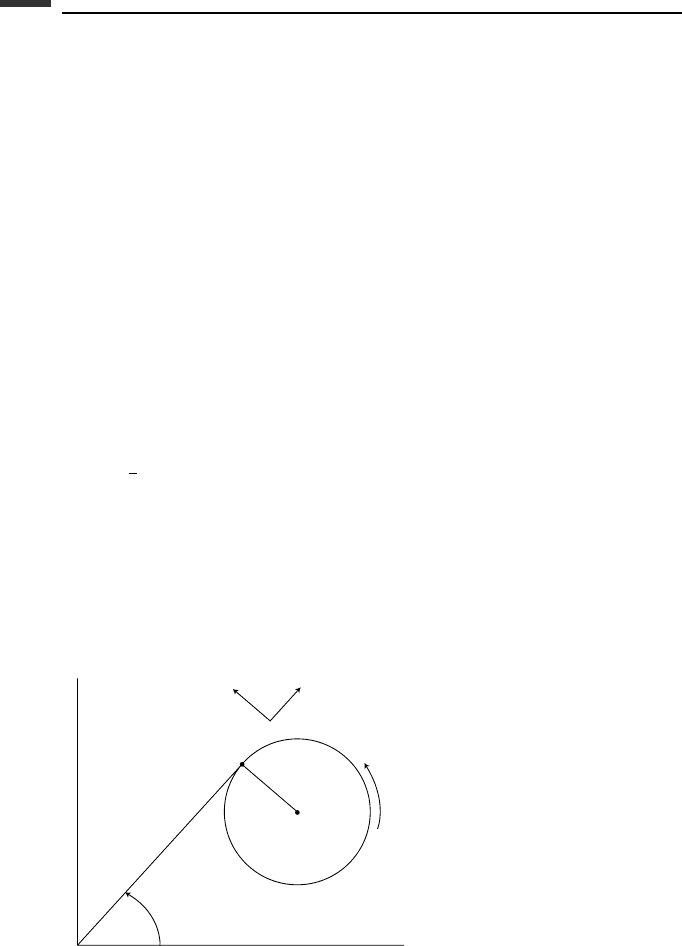
392 Introduction to numerical methods
It is interesting to observe that, for a rigid body rotating in free space, there is also
conservation of kinetic energy. This can be expressed as
2T = I
xx
ω
2
x
+ I
yy
ω
2
y
+ I
zz
ω
2
z
= 2E
0
(6.484)
which is the equation of an ellipsoid in body-fixed ω-space. It is called the energy ellipsoid.
Since both the angular momentum and the kinetic energy are conserved, the angular velocity
must satisfy (6.477) and (6.484). In other words, the point of the ω-vector must move on
the curve defined by the intersection of the momentum and energy ellipsoids. This closed
curve in body-fixed ω-space is called a polhode. Thus, for general initial conditions, the
path of the ω-vector relative to body axes is periodic. On the other hand, the path of ω in
inertial space is not periodic in the general case of rigid body motion.
Example 6.9 Consider the planar motion of a solid cylinder of mass m and radius r as it
moves in the xy-plane (Fig. 6.11). An inextensible string is wound around a cylinder and the
straight portion OP has a variable length l. We wish to obtain the differential equations of
motion and establish correction procedures based on the conservation of energy and angular
momentum.
First, notice that the angular velocity of the cylinder is
ω =
˙
θ +
˙
l
r
(6.485)
where
˙
θ is the angular velocity of the unit vectors e
l
, e
θ
, and the second term on the right is
the angular velocity of the cylinder relative to the unit vectors. The velocity v of the center
of the cylinder is equal to the velocity of the tangent point P, fixed in the string, plus the
velocity of C relative to P. Thus, we obtain
v = r ωe
l
+l
˙
θe
θ
= (
˙
l + r
˙
θ)e
l
+l
˙
θe
θ
(6.486)
y
x
m
l
r
ω
e
l
e
θ
θ
O
C
P
Figure 6.11.

393 Energy and momentum methods
Since the moment of inertia of the cylinder about its center is I =
1
2
mr
2
, we find that the
kinetic energy is
T =
1
2
m[(
˙
l + r
˙
θ)
2
+l
2
˙
θ
2
] +
1
4
mr
2
˙
θ +
˙
l
r
2
=
3
4
m
˙
l
2
+
1
2
m
l
2
+
3
2
r
2
˙
θ
2
+
3
2
mr
˙
l
˙
θ (6.487)
There is no potential energy, so Lagrange’s equation has the form
d
dt
∂T
∂
˙
q
i
−
∂T
∂q
i
= 0 (6.488)
This leads to the following l equation:
3
2
m
¨
l +
3
2
mr
¨
θ − ml
˙
θ
2
= 0 (6.489)
The θ equation is
m
l
2
+
3
2
r
2
¨
θ +
3
2
mr
¨
l + 2ml
˙
l
˙
θ = 0 (6.490)
These two equations can be solved for the individual accelerations, resulting in
¨
l =
1
l
2
3
l
2
+
3
2
r
2
˙
θ
2
+ 2r
˙
l
˙
θ
(6.491)
¨
θ =−
1
l
(2
˙
l
˙
θ + r
˙
θ
2
) (6.492)
These equations are then integrated numerically to obtain l and θ as functions of time.
The accuracy of the computations can be improved by using conservation of energy and
of angular momentum. Conservation of energy is expressed by the equation
E =
3
4
m
˙
l
2
+
1
2
m
l
2
+
3
2
r
2
˙
θ
2
+
3
2
mr
˙
l
˙
θ = E
0
(6.493)
where E
0
is a constant evaluated from initial conditions. Similarly, the conservation of
angular momentum about O is expressed as
P = m
l
2
+
3
2
r
2
˙
θ +
3
2
mr
˙
l = P
0
(6.494)
Because the motion is planar, this is a scalar equation. For this reason, we can correct
magnitude errors directly, rather than using the square of the magnitude, as we did in the
case of three-dimensional rotations. Note that P is also the generalized momentum p
θ
.
The errors in energy and angular momentum are
E = E − E
0
(6.495)
P = P − P
0
(6.496)

394 Introduction to numerical methods
where E and P are evaluated numerically at each time step of the computation. Let us
choose the velocity corrections in accordance with
˙
q = K
1
∇E + K
2
∇P (6.497)
where the gradients are taken in velocity space. The K s are chosen such that
∇E ·
˙
q =−E (6.498)
∇P ·
˙
q =−P (6.499)
Thus, we obtain
K
1
(∇E)
2
+ K
2
∇E ·∇P =−E (6.500)
K
1
∇E ·∇P + K
2
(∇P)
2
=−P (6.501)
The solution for the K s yields
K
1
=
1
[(∇E ·∇P)P − (∇P)
2
E ] (6.502)
K
2
=
1
[(∇E ·∇P)E −(∇E)
2
P] (6.503)
where the determinant of the coefficients is
= (∇E)
2
(∇P)
2
− (∇E ·∇P)
2
(6.504)
Let us choose a velocity space with components
˙
l and r
˙
θ in order to have dimensional
homogeneity. Then, we find that
∂ E
∂
˙
l
=
3
2
m(
˙
l + r
˙
θ) (6.505)
∂ E
∂(r
˙
θ)
=
3
2
m
˙
l +
1 +
2l
2
3r
2
(r
˙
θ)
(6.506)
(∇E)
2
=
9
2
m
2
˙
l
2
+
9
2
m
2
˙
lr
˙
θ
2 +
2l
2
3r
2
+
9
4
m
2
(r
˙
θ)
2
2 +
4l
2
3r
2
+
4l
4
9r
4
(6.507)
Similarly,
∂ P
∂
˙
l
=
3
2
mr (6.508)
∂ P
∂(r
˙
θ)
=
3
2
mr
1 +
2l
2
3r
2
(6.509)
(∇P)
2
=
9
4
m
2
r
2
2 +
4l
2
3r
2
+
4l
4
9r
4
(6.510)
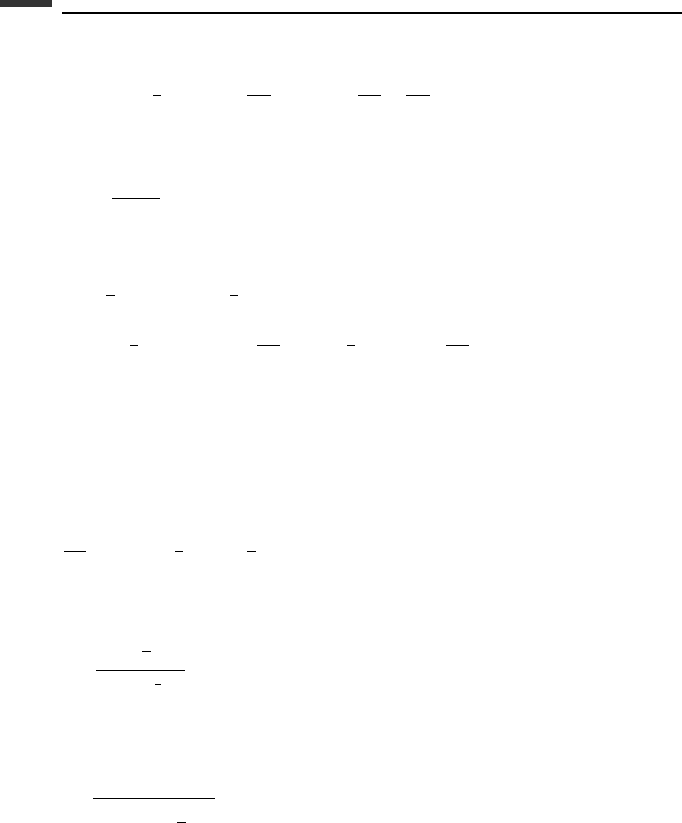
395 Energy and momentum methods
Also,
∇E ·∇P =
9
4
m
2
r
2 +
2l
2
3r
2
˙
l +
2 +
4l
2
3r
2
+
4l
4
9r
4
r
˙
θ
(6.511)
Then, substituting into (6.504), we obtain
=
3m
2
l
2
˙
l
2r
2
(6.512)
The corrections obtained by using (6.497) are
˙
l =
3
2
mK
1
(
˙
l + r
˙
θ) +
3
2
mr K
2
(6.513)
(r
˙
θ) =
3
2
mK
1
˙
l +
1 +
2l
2
3r
2
r
˙
θ
+
3
2
mr K
2
1 +
2l
2
3r
2
(6.514)
In this example, we chose the straightforward procedure of obtaining second-order equa-
tions (6.491) and (6.492) which are integrated numerically. The accuracy of the integrations
can be improved by using conservation of energy and angular momentum. But now let us
consider a second approach.
We note that θ is an ignorable coordinate, and therefore the corresponding generalized
momentum is constant in value.
∂T
∂
˙
θ
= m
l
2
+
3
2
r
2
˙
θ +
3
2
mr
˙
l = β
θ
(6.515)
where β
θ
is a constant. This equation can be solved for
˙
θ, giving the result
˙
θ =
β
θ
−
3
2
mr
˙
l
m
l
2
+
3
2
r
2
(6.516)
Upon substituting this expression for
˙
θ into (6.491), we obtain a single differential equation
of motion, namely,
¨
l =
4β
2
θ
− 9m
2
r
2
˙
l
2
6m
2
l
l
2
+
3
2
r
2
(6.517)
Numerical integration of (6.517) results in values of
˙
l and l as functions of time. For a
known
˙
l,thevalueof
˙
θ is obtained from (6.516), and this can be integrated numerically to
obtain θ as a function of time.
Equation (6.517) can also be obtained by using the Routhian method. The conservation
of angular momentum is inherent in the formulation, but the conservation of energy can be
used for error correction. By using (6.487) and (6.516), the total energy of the system can
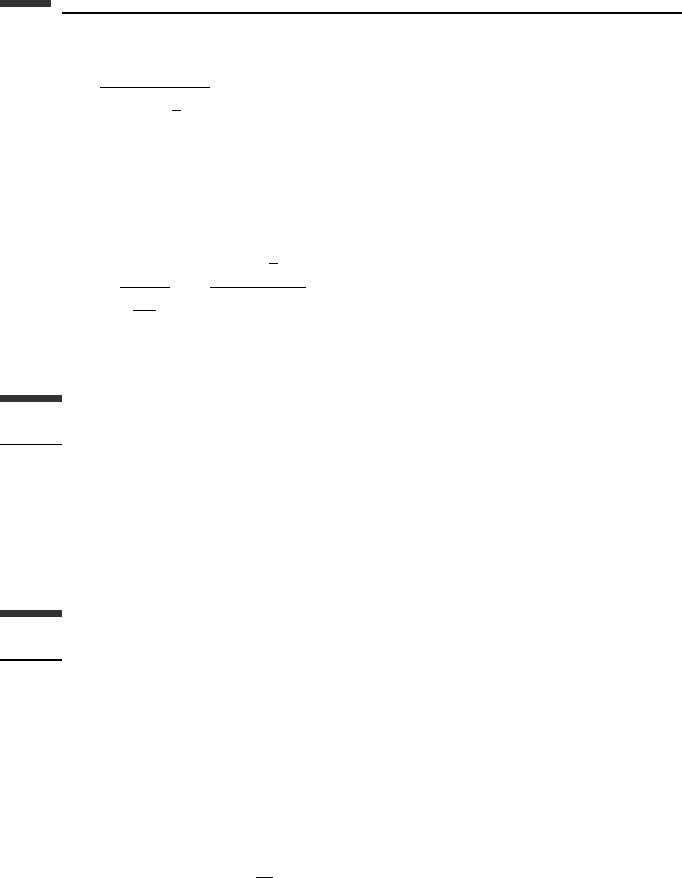
396 Introduction to numerical methods
be written in the form
E =
3m
2
l
2
˙
l
2
+ 2β
2
θ
4m
l
2
+
3
2
r
2
(6.518)
For an energy error E, the velocity correction is found from
∇E ·
˙
q =−E (6.519)
which results in the correction
˙
l =−
E
∂ E
∂
˙
l
=−
2
l
2
+
3
2
r
2
3ml
2
˙
l
E (6.520)
This correction should not be applied if
˙
l is very small compared to its maximum value.
6.7 Bibliography
Baumgarte, J. W. A new method of stabilization for holonomic constraints. Journal of Applied
Mechanics, 1983, Vol. 50, pp. 869–70.
Burden, R. L. and Faires, J. D. Numerical Analysis, 3rd edn. Boston: PWS Publishers, 1985.
Dahlquist, G. and Bjorck, A. Numerical Methods. Englewood Cliffs, NJ: Prentice Hall, 1974.
Hamming, R. W. Numerical Methods for Scientists and Engineers, 2nd edn. New York: Dover
Publications, 1973.
6.8 Problems
6.1. The differential equation
˙
y + y = 0 is to be integrated numerically using the modified
Euler method. Use a step size h = 0.1 and let y
n
= 1. (a) Solve for the actual numerical
error after one step. Compare this result with the value of E
n+1
obtained from (6.86).
(b) Using the mean value theorem to obtain E
n+1
,solveforthevalueofξ , where
0 <ξ <0.1 and t
n
= 0.
6.2. Given a second-order differential equation of the form
¨
y = f (y, t). Suppose it is
integrated using the algorithm
y
n+1
= 2y
n
− y
n−1
+
h
2
12
(
¨
y
n+1
+ 10
¨
y
n
+
¨
y
n−1
)
(a) Find the first error term. (b) Consider the differential equation
¨
y + ω
2
0
y = 0, where
ω
0
is a positive constant. The given algorithm is used to integrate this equation. An-
alyze the numerical stability by obtaining the corresponding characteristic equation.
Determine the range of step size h for numerical instability.
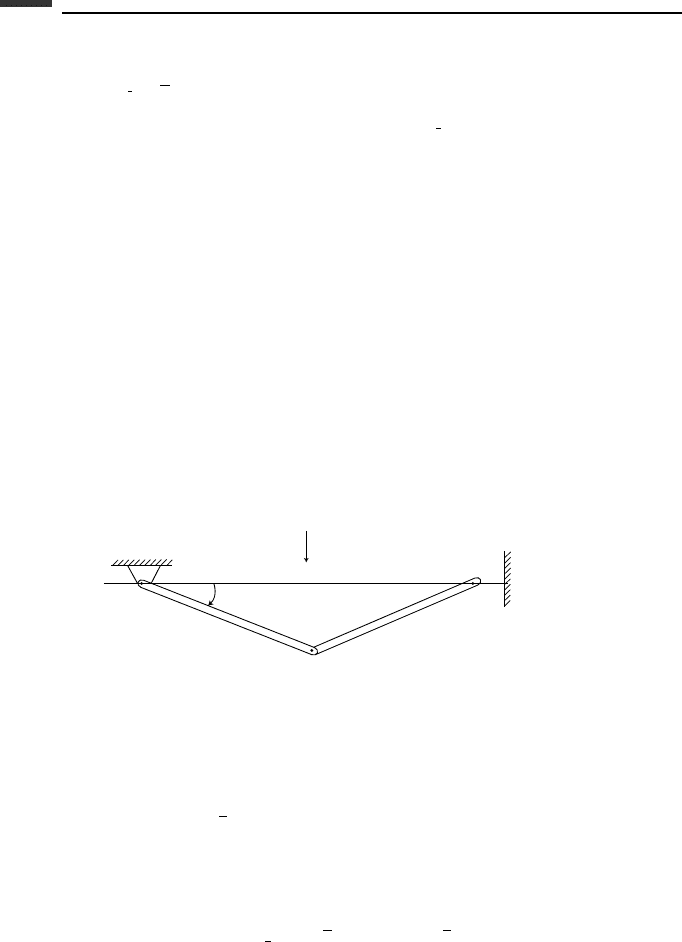
397 Problems
6.3. An extrapolation formula
v
n+
1
2
=
1
h
(ay
n
+ by
n−1
+ cy
n−2
)
is used to estimate the velocity v ≡
˙
y at time t
n+
1
2
. The step size h is uniform and the
values of y
n
, y
n−1
and y
n−2
are assumed to be known. (a) Solve for the coefficients
a, b, and c. (b) Find the first error term.
6.4. Given the system
˙
x =−x + y
˙
y =−3y
Suppose that Euler integration is used to obtain a solution. (a) Obtain the characteristic
equation for analyzing numerical stability. (b) Solve for the roots and give the range
of step size h for stability.
6.5. Two thin uniform rods, each of mass m and length l, are connected by a pivot at A.
There is a fixed pivot at O, and end B can slide freely on a rigid horizontal wire
through O. (a) Derive the differential equation of motion. (b) Let l = 1m,m = 1 kg,
g = 9.8m/s
2
and assume the initial conditions θ(0) = 0, ω(0) = 0 where ω ≡
˙
θ.
Tabulate numerical values of θ, ω, and ˙ω as functions of time for 0 ≤ t ≤ 1.5s.(c)
Find: (1) ω
max
and the corresponding time t and angle θ; (2) the time when θ = π/2;
(3) θ
max
and its time, assuming that B can pass through O.
O
B
A
m
m
g
l
l
θ
Figure P 6.5.
6.6. A particle of unit mass is constrained to follow the elliptical line of intersection of a
cone and a plane, as shown in Fig. 6.8 and discussed in Example 6.5 on page 376.
The equation of the cone represents the holonomic constraint
φ
1
= x
2
+ y
2
−
1
4
z
2
= 0
whereas the plane represents the second constraint
φ
2
= x + y + z − 1 = 0
Using units of meters and seconds, let g = 9.8m/s
2
and choose the initial condi-
tions x(0) = y(0) =−
1
2
(1 +
√
2), z(0) = 2 +
√
2,
˙
x(0) = 1,
˙
y(0) =−1,
˙
z(0) = 0.
(a) Starting with the differential equations in Lagrange multiplier form, use nu-
merical integration and the Baumgarte stabilization method with α = 2/ h and
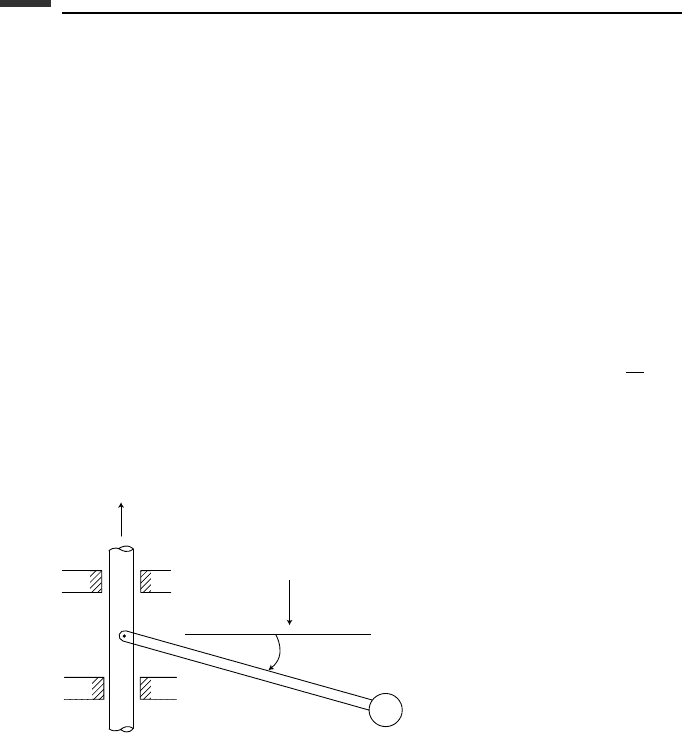
398 Introduction to numerical methods
β = 1/h
2
to obtain the motion of the system for 0 ≤ t ≤ 2. Tabulate the values
of x , y, z,v
x
,v
y
,v
z
,φ
1
,φ
2
and find the times of z
min
and z
max
. (b) Repeat the cal-
culations, but use the one-step method of stabilization. (c) Repeat step (b) but add a
one-step energy correction.
6.7. Consider a dumbbell with a knife-edge constraint sliding on the horizontal xy-plane,
as discussed in Examples 6.4 and 6.6, on pages 370 and 380 respectively, and as
shown in Fig. 6.6. Choose (x, y,φ)asqs and let v
x
≡
˙
x, v
y
≡
˙
y, ω ≡
˙
φ.(a)Derive
the six first-order differential equations of motion. (b) Assume m = 1, l = 2, and the
initial conditions are x (0) = 0, y(0) = 0, φ(0) = 0, v
x
(0) = 0, v
y
(0) = 0, ω(0) = 1.
The nonholonomic constraint equation is g
1
=−
˙
x sin φ +
˙
y cos φ = 0. Use the one-
step constraint stabilization method. Find the numerical values of x, y,φ,v
x
,v
y
,ω,
and g
1
, at the times t = 0.1, t = 1.0, and t = 10.
6.8. A pendulum of particle mass m and length l is forced to rotate about a vertical axis at
a constant rate . The pendulum angle θ is measured downward from horizontal. (a)
Derive the differential equation for θ . (b) Assume that g/l = 4s
−2
, =
√
10 rad/s
and the initial conditions are θ (0) = 0, ω(0) = 0 where ω ≡
˙
θ. Integrate the differ-
ential equation numerically using RK-4 with h = 0.001 s. Tabulate values of θ, ω,
and ˙ω over the time interval 0 ≤ t ≤ 1.5 s. (c) Find θ
max
and ω
max
, giving the time
when each occurs.
O
g
l
m
θ
Ω
Figure P 6.8.
6.9. A rigid body has an inertia matrix
I =
1000 0 0
0 2500 0
0 0 3000
kg·m
2
with respect to its center of mass. Euler parameters are used to specify the orien-
tation. A constant body-axis moment M
z
= 15 000 N·m is applied to the body. The
initial conditions are ω
x
(0) = 15 rad/s, ω
y
(0) = 0, ω
z
(0) = 0,
x
(0) = 0,
y
(0) = 0,
